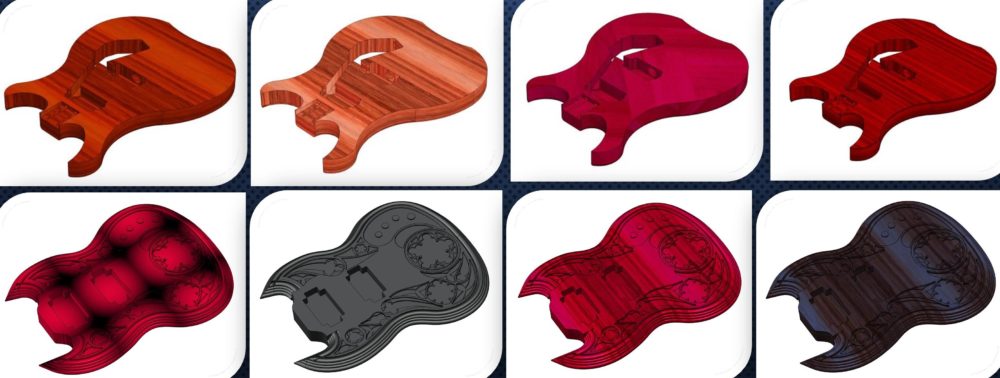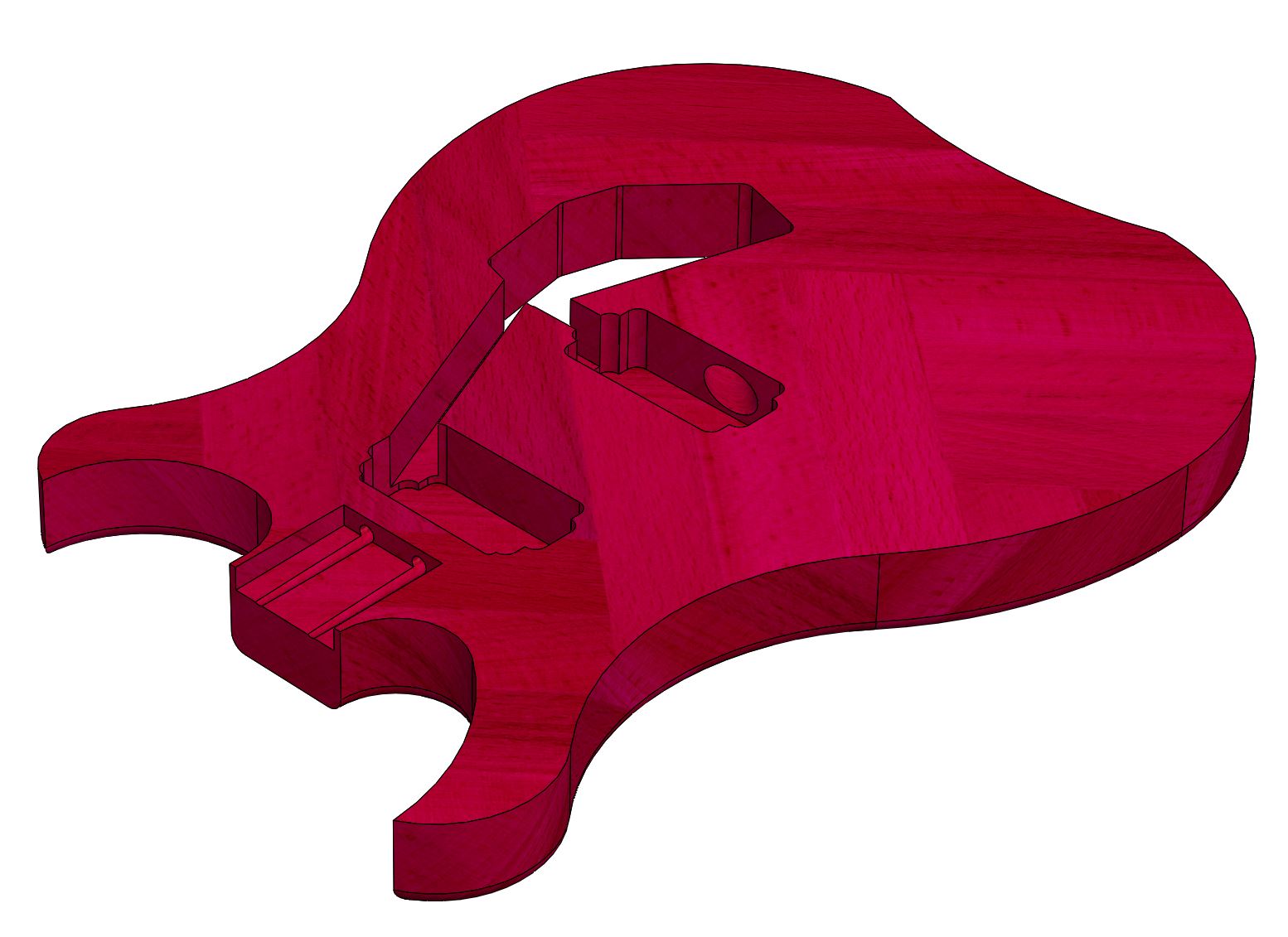I. INTRODUCTION
Building off of the last blog post, Design Review 1, a lot of the initial plans of how I would make the guitar has changed, due to the closure of campus resources and the precautions taken because of COVID-19. These changes are later detailed in part V. Timeline and Logistics: Manufacturing Changes due to COVID-19. If Design Review 1 was previously reviewed, then part V of this design blog post can be skipped to as most of the information of what the guitar and the vision for it has remained the same. The presentation done is in the Slack channel – podB – where I uploaded the Zoom lecture. The following Zoom lecture replaced that initial lecture.
To recap for any new viewers, for the final project of the course MCEN 5228: Aesthetics of Design, I will be making an electrical guitar, or more specifically, making the body (figure 1) and reusing components of an old electrical guitar. It completes a task in that it can be operated onto and it produces a reflecting sound through electrical components; and in terms of an aesthetic, the artistic manipulation of the hardwood body will be a challenging objective. This project will satisfy the following requirements:
- Deliverables will be a functional artifact that satisfies an aesthetic of your choice, plus documentation
- The artifact must be dynamic or complete a task (demonstrating form/function balance)
- Has to be aesthetic

Figure 1: Initial CAD Design of the electrical guitar body.
II. INSPIRATION
My friend is currently building an electrical guitar but recently graduated and can’t use the facilities’ resources on campus, so he’s currently having to hand-make it. After discussing the class with him, It is a possible opportunity to help him make the electrical guitar, having both a great function and aesthetic balance. He has an old guitar that he can re-purpose the electrical components (Figure 2) to produce the sound. The main objective, then, would be to build an aesthetic body of the guitar, and then re-purpose the electrical components of his old electrical guitar to produce something aesthetically amazing.
Figure 2: Friend’s old guitar that we will re-purpose for the electrical components.
III. VISION
The overall vision would refurbish the guitar in figure 2, mainly the body which is not aesthetically pleasing currently, and then overlaying that aesthetic to all the other components. The aesthetic itself of the body, then is very important and a number of aesthetics have been played in my mind. Looking my planned asthetic, I hope to combine a streamlining aesthetic with a modern matte black aesthetic, both considered at their respective points as very modern aesthetics.
Streamlining aesthetic (figure 3,4) has a very shiny, curvy, and aerodynamic look to it, naturally intrinsic to electrical guitars I feel. The aesthetic emerged in the 1930s and was used in industrial design, namely: railroad locomotives, telephones, toasters, buses, appliances, and other devices conforming to the sleek and modern impression. The electrical guitar itself was developed in 1932, so I believe this type of aesthetic is very fitting for such a piece.

Figure 3. Motor Car No. 9 (without tail fin) with streamline aesthetic. Very smooth and soft aesthetic that can would work amazing on an electrical guitar. Source[1]: https://www.nybooks.com/daily/2013/11/13/streamline-dreamer/

Figure 4: Another Streamline moderne automobile in the 1930s. Source[2]: https://www.hemmings.com/blog/2014/05/29/1930s-auto-design-art-deco-and-streamline-moderne/
My thought behind combining a matte black modern aesthetic onto what once was considered a very modern aesthetic will try to infuse both modern aesthetics into my project. Matte finish are similar to flat finishes with non-glossy finish to diffuse reflection. However, the two aesthetics do contrast each other in some ways as streamline aesthetic is shiny, so I imagine both will exist but not be mixed on the electrical guitar (Figure 5).

Figure 5: There is a separate shiny piece that contrasts with the matte black finish of this particular electric guitar, something I hope to do better.
IV. DESIGN
I’ve played around so far with a couple different designs on CAD, drawing them alongside different images that I pulled up from Google and combined the best designs into a body that I’d like (Figure 1)(Figure6). I didn’t spend too much time on hand sketching in order to budget my time, given the limited time and scope of this project. The actual design I plan on using is shown in figure 6, as it is the current file I have compatible with the ITLL CNC machines, which is what I originally intended to use to carve the guitar. Some post-renders of different base layer aesthetics are seen in figure 7.

Figure 6: Design #1, Maple Hardwood design

Figure 7: Design renders of both the CAD electrical guitars made in SolidWorks.
V. TIMELINE AND LOGISTICS: MANUFACTURING CHANGES DUE TO COVID-19
To be concise, here are a number of manufacturing logistics that have changed due to COVID-19 and how I plan to implement them:
- (1.) I can no longer use ITLL CNC Machines to carve the body and the pickups.
- Alternative: Hand-make the body, carve with hand saw or band saw. Sand edges down.
- For pickups: use hand-drill and saw afterwards. Try asking for a router and router bits if anyone has, or a router kit/router template for an electrical guitar in Slack.
- Alternative: Hand-make the body, carve with hand saw or band saw. Sand edges down.
- (2.) I can no longer use ITLL Laser Printer for the pick guard.
- Alternative: Design a more geometric pick guard, perhaps in the shape of a trapezoid that sits under the strings. Pick-guard material will be sourced from: https://www.wdmusic.com/wd-custom-pickguards-material-details.html. But will re-purpose sheet metal If found.
- (3.) Body material will be re-evaluated, since this will now be a hand-made electrical guitar body.
- I will use an inexpensive ash-body wood or plywood material as I am hesitant that my project will meet my initial vision’s standards.
- (4.) The original stretch goals no longer exist.
- The stretch goal is now replaced with the initial goal of this project, to refurbish and have a functional electrical guitar, meeting the previously stated requirements.
- (5.) The Aesthetic will be minimalist
- I do not have the purchased lacquer or paints. Whether or not I can source these materials will largely affect the overall aesthetic of the guitar. For now, it will be labeled as minimalist, using what I can to produce something simple yet eye-appealing.
In regards to the timeline of this project, there remains 4 weeks until the final presentations. Here is the following schedule I will try to abide by to complete the guitar.
- Week 1: March 18- March 25: Make the body of the guitar with the available plywood with a band-saw or hand-saw. Order Lacquer and paint if possible.
- Week 2: March 25 – April 1 (Spring Break): Drill the pickups and sand them down, try to fit re-purposed components into the body. Deliverable due: Blog post due 4/1.
- Week 3: April 1- April 8: Finish placing all the electrical components into body, make the pick guard and fasten to guitar. Deliverable due: Blog Post due 4/8.
- Week 4: April 8 – April 15: Paint the guitar and finish the overall aesthetic of the guitar. Work on final presentation. Deliverable due: Blog Post due 4/15, Final Presentation due.
VI. CONCLUSION AND PRESENTATION
I will hope for the best but plan for the worst. Hopefully I will have a working guitar by the end, maybe even just the body would be nice. My plan is detailed in previous. My Design Review presentation is on slack channel – podB – where I recorded and uploaded the lecture via zoomas the week’s facilitator.
VIII. REFERENCES
[1] Filler, Martin. “Streamline Dreamer.” The New York Review of Books, www.nybooks.com/daily/2013/11/13/streamline-dreamer/. [2] Hemmings.com, www.hemmings.com/blog/2014/05/29/1930s-auto-design-art-deco-and-streamline-moderne/. [3] “Home.” Guitar Wood Experts, guitarwoodexperts.com/electric-guitar-wood/?sort=featured&page=4.

4 Comments. Leave new
Hey Will, it seems like you’ve put a lot of thought into your project. It seems like you’ll have to make a lot of changes to your original design because of the current outbreak. I like how detailed your design changes are and how you provided alternative options. I’m excited to see how your project turns out under the current circumstances.
Wow will these renders look great. I love the idea of using classic black but giving it a modern twist through the use of a matte finish. I like the curves and how that comes from a historical place. Keep up the good work.
Hi, Will,
I think your revised plan sounds promising. I imagine it’ll still be challenging, to handmade a large amount of the parts, but hopefully you can achieve making a good guitar at the end of the project.
Best,
Xiang
Hello Will, it looks like you’re planning for as much as you can with the unfortunate situation. Do you suspect there will be any issues getting the paints you need? Do you require any specific type of paint? Even if you utilize a cheaper paint, I think it will be an important aspect of your project.